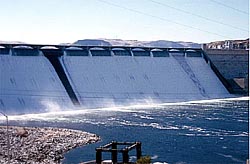About the Columbia River: Above Grand Coulee Dam

The free-flowing headwaters of the Columbia River are located in the Canadian Rockies where snowmelt and spring water fill Columbia Lake near British Columbia's border with Alberta. From the headwaters, the river flows 600 miles downstream and swells behind Grand Coulee Dam. Grand Coulee is the first of 14 dams along the Columbia River.
Below are summaries of key EPA projects in the upper part of the Columbia River basin, from the U.S.-Canada border to Grand Coulee Dam.
Upper Columbia River Contamination Investigation
EPA and other studies have found contamination in sediment in the upper Columbia River from past industrial practices, including heavy metals and other pollution like dioxins and furans. A large metal smelter in Trail, British Columbia, is a primary source of metal contamination to the site. Teck Cominco, owner and operator of the smelter, is funding and leading parts of an environmental investigation under EPA's oversight. The investigation extends from the U.S.-Canada border to the Grand Coulee Dam, and includes surrounding upland areas in northeast Washington.
Bunker Hill Superfund Site
The Bunker Hill Mining and Metallurgical Superfund Site, located in northern Idaho and eastern Washington, was listed on the Superfund National Priorities List in 1983. EPA and its partners have made a great deal of cleanup progress, reducing risks to the health of people and the environment. More work remains, and the cleanup is expected to take decades. It's one of the most vast and complex Superfund sites in the U.S., within one of the largest historical mining districts in the world. The site includes mining-contaminated areas in the Coeur d'Alene River corridor, adjacent floodplains, downstream water bodies, tributaries, and fill areas. It also encompasses the 21 square mile Bunker Hill "Box", located in the area surrounding the historical smelter operation.
Spokane River Regional Toxics Task Force
The Spokane River Regional Toxics Task Force (Task Force) leads efforts to find and reduce toxic compounds in the Spokane River. The goal of the task force is to develop a comprehensive plan to bring the Spokane River into compliance with water quality standards for PCBs (polychlorinated biphenyls). These pollutants exceed water quality standards in several segments of the river.
The Spokane River Regional Toxics Task Force is actively working to:
- Further analyze the existing and future data to better characterize the amounts, sources, and locations of PCBs and other toxics as defined above entering the Spokane River.
- Prepare recommendations for controlling and reducing the sources of listed toxics in the Spokane River.
- Review proposed Toxic Management Plans, Source Management Plans, BMPs, and data to be used to develop performance-based limits.
- Monitor and assess the effectiveness of toxic reduction measures.
The Task Force operates under a Memorandum of Agreement which was signed in 2012 by Spokane County, the City of Spokane, the Liberty Lake Sewer and Water District, Inland Empire Paper Co., Kaiser Aluminum, Spokane Regional Health District, Washington State Department of Health, the Spokane Riverkeeper (a program of the Center for Justice), the Lands Council, Lake Spokane Association and Washington State Department of Ecology. The US Environmental Protection Agency, Idaho Department of Environmental Quality, Tribes, and Avista have advisory roles.
